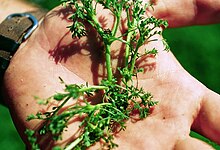This article includes a list of general references, but it lacks sufficient corresponding inline citations. (July 2023) |
Soliva sessilis, one of up to nine species of the genus Soliva, is a low-growing herbaceous annual plant. Its common names include field burrweed,[2] Onehunga-weed,[3] lawn burrweed, lawnweed, jo-jo weed[4] and common soliva. It is one of several plants also known as bindi weed, bindii, or bindi-eye.
| Soliva sessilis | |
|---|---|

| |
| Scientific classification | |
| Kingdom: | Plantae |
| Clade: | Tracheophytes |
| Clade: | Angiosperms |
| Clade: | Eudicots |
| Clade: | Asterids |
| Order: | Asterales |
| Family: | Asteraceae |
| Genus: | Soliva |
| Species: | S. sessilis
|
| Binomial name | |
| Soliva sessilis | |
| Synonyms | |
| |
A weedy plant known for its tiny sharp-needled seeds. It appears with small feathery leaves reminiscent of parsley, with an exposed upward-pointing rosette of seeds in a pod nestled at the branch junctions. Eventually small flowers appear if the plant is allowed to develop. Those familiar with the plant may also know it as "bindi patches", which can't be walked on barefoot. Dogs and cats are no less affected and tend to avoid areas where they have encountered it.
Originally native to South America, the plant is now well established in many places around the world, including Australia, New Zealand, southwest France, Hawaii, California, and several other states in the United States. It is mainly found in parks and ovals, though it has also become an invasive species in lawns in the southeast USA, Australia and New Zealand.
Bindi weed can be manually removed by pulling it out at the root, usually when it's grown big, and started to flower, and before seeding—especially after rain when the ground is softer. A hand tool that pinches the tap root and enables some leverage while getting in under the central core is the best method.
Bindi can be treated with herbicide. Late winter and early spring are the best times to destroy the weed before its seeds germinate. Effective herbicides are typically combinations of MCPA and Dicamba, which target broad-leaved plants but not grasses. These chemicals have similar effects as natural plant auxins, and their increased concentrations cause unnatural plant growth which kill the plant. Mowing grass to a higher level will allow more competitive plants to thrive in the area. Bindi weed also favours compacted ground, so aerating the soil should also reduce the presence of the plant
References edit
- ^ "Cotula sessilis (Ruiz & Pav.) Stace | Plants of the World Online | Kew Science". Plants of the World Online. RBG Kew. Retrieved 5 July 2023.
- ^ USDA, NRCS (n.d.). "Soliva sessilis". The PLANTS Database (plants.usda.gov). Greensboro, North Carolina: National Plant Data Team. Retrieved 19 November 2015.
- ^ BSBI List 2007 (xls). Botanical Society of Britain and Ireland. Archived from the original (xls) on 2015-06-26. Retrieved 2014-10-17.
- ^ Stace, Clive A.; Thompson, Hilli (2021). New flora of the British Isles. Margaret Stace (Fourth edition, reprinted with corrections October 2021 ed.). Middlewood Green, Suffolk: C&M Floristics. p. 799. ISBN 978-1-5272-2630-2.
- C.Michael Hogan, ed. 2010. Soliva sessilis, Encyclopedia of Life
- Jepson Manual Treatment
External links edit
Media related to Soliva sessilis at Wikimedia Commons